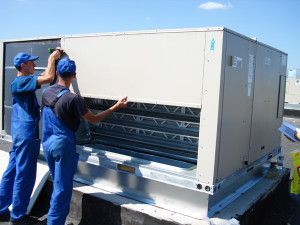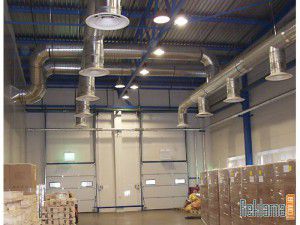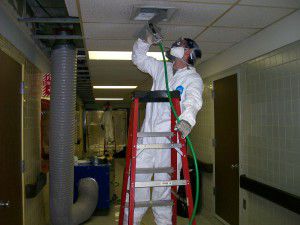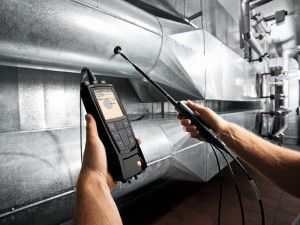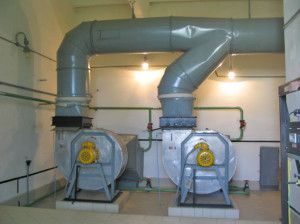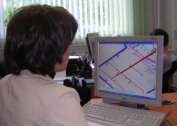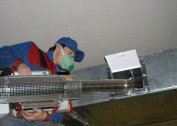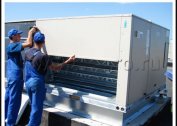The operating instructions for ventilation units and systems set out the basic requirements for the use of equipment. Exactly following the instructions allows you to ensure the indoor air parameters laid down in the project.
The ventilation instruction manual is created for the maintenance staff; it does not take into account the specifics of the enterprise. Based on the general operating instructions, working documents are created on the use of the ventilation unit, as amended by the operating conditions of a particular enterprise.
Scope and General Installation Information
-
The instructions set out the requirements for the launch, commissioning and use of ventilation systems for existing and commissioned facilities;
- Ventilation systems are necessary to create certain temperatures, humidity, dust in accordance with the requirements of sanitary services;
- For each zone of the enterprise (working, auxiliary, technical), the parameters of temperature, air velocity and humidity are set in accordance with the rules for the technical operation of ventilation systems;
- Temperature and humidity indicators are set based on a minimum summer outdoor temperature of +25 degrees. In the instruction manual for the equipment, it is necessary to indicate the optimal values of temperature and humidity for a particular enterprise;
- The amount of supply air depends on the volume of the hall and is determined on the basis of SNiP 2-33-75 and equipment operating instructions.
Testing, adjusting and adjusting ventilation systems
-
The commissioning and use of equipment is carried out:
- in rooms specially prepared for acceptance;
- at functioning enterprises as planned preventive measures.
- High-quality and uninterrupted operation of ventilation equipment is guaranteed by the work carried out before equipment acceptance:
- inspection, adjustment and testing of all installed equipment;
- scheduled inspections and adjustment of already operating equipment;
- operation of ventilation systems according to the rules, with periodic scheduled repairs.
- Adjustment and testing of assembled ventilation systems is carried out by the installation company. Sometimes this function is transferred to specialized organizations;
- Start-up and adjustment are carried out with partial loading of the main equipment or in its absence. This allows you to create design loads on the ventilation unit. In the process of testing and commissioning control:
- correspondence of pressure, number of revolutions of fans and pressure to design values;
- presence of leaks in ventilation ducts;
- compliance of air volumes with design data;
- temperature parameters;
- pump functions;
- humidification nozzle functions;
- indicators of air supplied to the building.
An error of 10% is allowed on both sides in terms of air volume, 2 degrees in temperature of the supplied air and 5% in humidity.
- Adjustment and commissioning work is based on the instructions for setting up and testing ventilation equipment;
- If defects are detected, a list of the established sample is compiled, defects are eliminated;
- Local exhaust and supply units (umbrellas, suction) are tested after starting the main equipment;
- Defects indicated in the statement must be removed before testing;
- The system is put into operation after correction of all detected defects according to the instructions;
- The operation parameters of the ventilation unit are entered in the equipment passport.
Operation of ventilation units and systems
-
In large enterprises, the operation of the ventilation system is controlled by the main power engineer or mechanic:
- up to 100 units are serviced by a fan technician;
- a group led by an engineer is hired to service 100 to 200 plants;
- if the company has more than 200 ventilation units, it is necessary to dial a ventilation bureau.
- For serviceability and integrity of installations are responsible for the heads of sections;
- According to the instruction manual for ventilation systems, the chief engineer is responsible for the operation of the equipment;
- According to the rules of technical operation of ventilation systems, uninterrupted operation of the equipment is ensured by:
- the availability of personnel servicing ventilation units;
- control measurements of air in the building;
- periodic testing of equipment performance;
- timely repair of equipment.
- The operating mode of ventilation units is specified in the instructions. When compiling it, special conditions in each ventilated room are taken into account. This equipment manual contains:
- characteristics of the condition of the equipment;
- temperature and humidity in the workshops (rooms);
- information about the performance and power of the fans for each point;
- circuit off and on equipment;
- the possibility of changing the temperature, humidity and volume of air supplied;
- the specifics of servicing individual nodes;
- the plan and procedure for cleaning filter elements, heaters and other components, the maximum permitted indicators of resistance to air flow, upon reaching which cleaning is required;
- actions in case of accidents or fires;
- instructions for the operation of ventilation systems stipulate the procedure and schedule for monitoring the effectiveness of equipment.
The procedure for starting and stopping ventilation systems
- Supply air startup sequence:
- check: the insulated air intake valve is closed. In the heat it should be open;
- tightly cover the hatches, doors and chambers of the ducts;
- run self-cleaning filters;
- the heater bypass valve closes tightly in the cold season and opens in the warm season;
- check the position of the throttle device;
- start water and steam heaters;
- check pressure and temperature indicators on the coolant supply;
- start nozzles if there is an irrigation chamber;
- open the insulated valve;
- start the engine;
- monitor the supply air temperature using a thermometer located behind the fan;
- when overheating, slowly open the bypass valve of the heater, lower the temperature to the required values. With a lack of temperature, slowly close the valve on the air supply;
- if the equipment provides recirculation, the supply air temperature is regulated as follows: in case of overheating, reduce the volume of recirculation air and increase the flow from the street. With insufficient temperature, do the opposite;
- air humidity is constantly monitored using stationary psychometers.
- The sequence for starting the exhaust equipment:
- make sure that the doors of the air duct and dust collector doors are carefully closed;
- start the water dust separators by opening the water tap and check the discharge of water from the dust separators into the sewer;
- check: whether the throttle device is in the required position;
- start the engine;
- control the position of the throttling devices located behind the suction.
- It is necessary to start and stop ventilation systems in the sequence specified in the instruction manual;
- General exchange plants are stopped 15 minutes after the entire equipment of the workshop is stopped. The first - supply, after exhaust;
- According to the ventilation instruction manual, the general exchange supply and exhaust installation is started 15 minutes before the start of the work shift. The exhaust units are the first to start, after the supply ones;
- The stop sequence of the exhaust equipment:
- stop the engine;
- stop the water supply to the wet dust separators.
- Shutdown of supply equipment:
- stop the engine;
- carefully cover the insulated valve;
- stop the nozzles in the chamber;
- disconnect power to steam heaters.
Water heaters are stopped only if the company or workshop stops working for a long period (for example, repair). In normal operation, when the inflow is switched off, it is necessary to reduce the amount of water supplied to the heater so that the latter does not freeze,
- turn off the power of self-cleaning filters;
- According to the rules of operation of ventilation units, in the presence of ventilation with a heating function, during off-hours they are transferred to the recirculation mode;
- The exhaust equipment starts 5 minutes before the start of work of machines that generate dust and heat, stops 5 minutes after they stop;
- Doors and hatches of ventilation chambers must be kept tightly closed. Penetration of employees into them is possible only for repair or routine inspections;
- The outer surfaces of engines, heaters, fans, chambers, appliances must be kept clean;
- According to the rules, during the operation of the ventilation system, it is necessary to periodically monitor the air parameters in the workshops (rooms) using measuring instruments;
- When upgrading technology or moving machines in the workshop, the configuration of the ventilation system changes;
- The use of ventilation equipment is agreed with the firefighters;
- Any of the working ventilation units must have a serial number and letter designation of the established sample. They are recorded in the ventilation system operation log. For example: VU-3 - exhaust installation 3.
The designation is written on the ventilation duct near the fan or the casing of the latter.
Prevention and repair of ventilation systems
-
Each site has its own sample logbook for the operation of an industrial ventilation system. The data is entered into it:
- about breakdowns (date and time of detection);
- about emergency and planned shutdowns of equipment for repair, during a power outage or coolant;
- on troubleshooting problems and regular system startup;
- dates, time of duty and surnames of technicians.
- A card for preventive and repair measures and a passport are opened for each installation.
The data on pre-launch runs, major repairs, modernization, reconstruction are entered in the passport of the ventilation unit.
- The ventilation instruction manual contains a repair card that includes: the date of the start of repair and the end, type of repair (medium, current or major), a short description of the work, determination of the quality of the repair;
- In the journal on the operation of ventilation systems every month it is planned to check and carry out minor repairs. A routine inspection determines the condition of the equipment, detects visible defects that are recorded in the defective list.During the current repair, the detected defects are eliminated, worn mechanisms are replaced, the equipment is cleaned and disinfected (if necessary). For current and secondary repairs, the equipment is not dismantled, all procedures are carried out right on the spot. At the end of the repair, the functionality of the ventilation system is tested, the results are recorded in the operation log;
- The ventilation engineer draws up an overhaul plan. Equipment is dismantled and delivered for repair to workshops. At the end of the repair, the system is debugged and started. All launch results are recorded in the current sample operation log of the ventilation unit;
- Diagnostic examinations are planned for periods of shutdown of ventilation (non-working period). Their terms are agreed with the enterprise management and power engineers;
- The operating instructions for the ventilation unit indicate the cleaning time for filters, ducts, grilles, fans. In determining the timing takes into account the specifics of the enterprise;
- Internal surfaces are cleaned through specially equipped hermetically sealed hatches;
- Pneumatic compressed air units are used to clean air heaters;
- The ventilation ducts are cleaned according to the scheme:
- the fan stops;
- dust collectors are cleaned;
- the dirtiest areas are cleaned towards suction.
- If industrial production is associated with the release of aggressive substances that destroy metal ventilation ducts, it is necessary to monitor their integrity and repair on time. The terms of repair are determined by the operating instructions for the operation of ventilation systems;
- If the production is fire or explosive, the ventilation efficiency is tested once every 12 months, the results are recorded in the ventilation system operation log.
Procedures for reducing noise from ventilation equipment
Noise from the equipment (aerodynamic and mechanical) spreads through the ventilation ducts, creating levels that exceed sanitary standards.
The source of mechanical noise is rubbing, creaking, knocking and vibrating parts.
The source of aerodynamic noise is air turbulence, air jet pressure.
- According to the instructions for use of ventilation equipment, there are measures to eliminate mechanical noise:
- neat fit of spare parts;
- balancing of rotating parts;
- hard mount fan;
- competent selection of bearings and their installation;
- if possible, the use of plain bearings instead of ball bearings;
- the use of V-belt drives;
- installation of fans whose axis is the motor shaft;
- additional insulating casing for the fan;
- fan installation in a special room;
- soundproofing of rooms or ventilation chambers with absorbing plates;
- installation of vibration isolating bases for equipment.
- To reduce aerodynamic noise:
- reduced fan speed;
- fans with a special shape of the blades are installed;
- a smooth collector at the inlet of the axial fan is used;
- air ducts are lined with absorbing plates from the inside;
- silencers are installed in places of air turbulence.
So that the noise from the operation of the ventilation unit does not overlap the noise of the main equipment, it must be lower by 5 or more decibels.
Safety precautions when starting, debugging and using ventilation equipment
A separate chapter of the operating instructions for the general exchange of supply and exhaust ventilation is devoted to safety measures:
- Only persons who have undergone special training and have the qualification III for TB work with the equipment. Information about the briefing is logged.After studying the rules of operation of ventilation systems, employees put a signature in the journal;
- Ventilation is put into operation only after the installation of all protective covers and guards according to the instructions. All staircases and high-rise platforms are protected by a handrail;
- Maintenance hatches are provided with mechanisms for fixing in the open state;
- All ventilation equipment should be installed at a height above 1.8 meters from the floor;
- Do not block access to the ventilation equipment with foreign objects;
- Any repair and cleaning work is carried out with the equipment completely disconnected from the mains;
- If ventilation equipment emits abnormal sounds, operating rules require immediate shutdown of the unit.
What other prohibitions exist when operating ventilation and chimneys, the video will tell:
